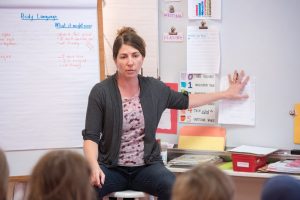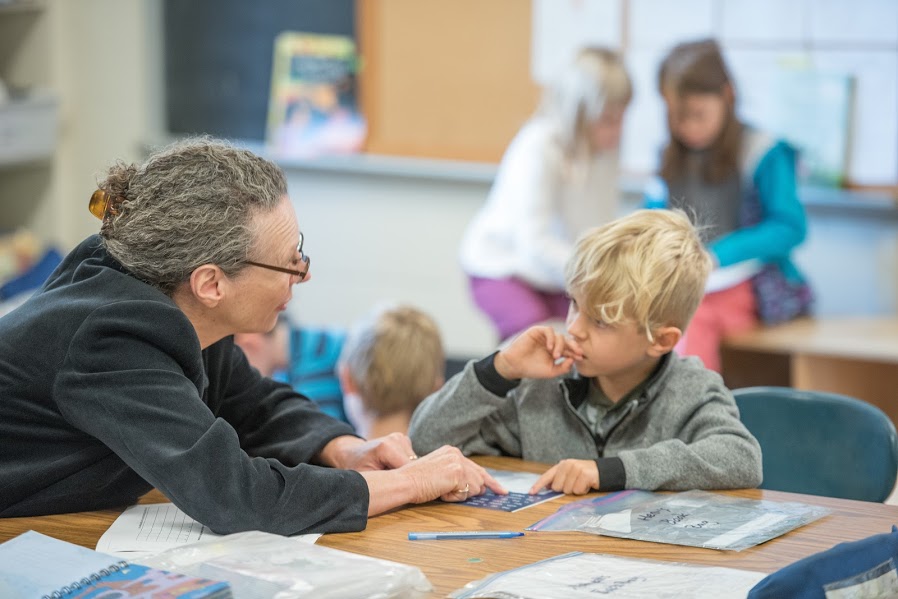“If the structure does not permit dialogue, the structure must be changed” –Paulo Freire
In the classroom as in life, difficult conversations catalyze powerful learning. Second grade teachers at the Smith College Campus School, Robbie Murphy and Maggie Bittel, teach this truth by example. In their annual unit on the Civil Rights Movement and the Montgomery Bus Boycott, constructive dialogue about challenging topics is not only “permitted” but promoted. Students grapple with past and present issues of racial inequality through a guided, interactive read-aloud of Richard Kelso’s Walking for Freedom, supplemented by projects that turn observation into inquiry, and inquiry into action.
The unit builds upon a long-standing first grade unit at the Campus School that is focused on individuals who inspire great change in the world. Each first grader is assigned a “Great Changer,” a historical figure such as Satchel Page, Yo-Yo Ma, Georgia O’Keefe, or Sally Ride, about whom they become an expert through research, writing, and art.
In second grade, students carry knowledge of these individuals into discussions about human rights. After students generate their own list of universal rights, teachers facilitate a comparison between their ideas and the United Nations Human Rights of the Child, often revealing much synonymy. “Can people survive without love?” one student asked during this year’s lesson—a question that inspired others to think and talk about issues of safety, sustenance, and well-being. “What is survival?” teachers probed, framing and propelling classroom discussions. “What makes a good life?”
An important curricular goal of the unit is to invite children to think critically about matters of identity. One of the ways in which Robbie and Maggie inspire such inquiry is through an activity that asks students to name their own skin color (“pancake” was one resonant term!), thereby acknowledging the array of appearances that melanin lends and disrupting the binary skin color descriptors that pervade many discussions of race. “What’s really important in this conversation is for people to define for themselves how they talk about their skin,” Maggie says to her students, guiding them through discussions about misrepresentation and nuance.
Students return to their classrooms in January ready for focused study. “Civil Rights are your rights to participate in your community,” Robbie (pictured above) shared with her students at the launch of this year’s unit. “Going to school, getting to vote, those are examples of Civil Rights.” Students were asked to recall their Great Changers: “[Great Changers] help people understand things differently. They are leaders,” Robbie said in segue. “For the next couple of months, we are going to study—not just leaders—but how big groups of people work together to make change when they notice something unfair about the world.”
On a wall in Robbie’s classroom, a big construction paper tree displays student-generated values that serve as tenets for classroom conduct: “The 2M Community is Rooted in Care,” it says at the top. With such care, students and teachers honor, but transcend, “known” heroes by considering the unsung community members who work to make social movements possible. Recalling the qualities that define “Changers,” second graders consider how even these qualities alone cannot institute change without collective participation and mobilization. Paulo Freire, a pioneer of social justice education, writes in Pedagogy of the Oppressed, “[O]ppressors do not favor promoting the community as a whole but rather selected leaders” (143), and it is to that end that second grade teachers stress the role of community in change.
—
Across the hall, second grade teacher Maggie Bittel also eases her students into Civil Rights study by reflecting upon Great Changers. Tacked to her blackboard is a sign with adjectives like “Brave; Strong; Determined” scrawled in magic marker. These characteristics, students decided, define the work of Changers.
But vulnerability informs change, too, and Maggie acknowledges that humanizing fact. “Friends had some feelings last week,” she said to her class as they sat down on the rug. “[Our lesson] was making you feel sad, compassionate, angry.” “I felt teary,” one student shared—a comment that initiated a wave of “Campus School shimmies,” or the hand motion that silently signals agreement at the Campus School.
Maggie asked her students what Dr. King and other activists might say to themselves in the face of difficulty or fear. Kids brainstormed phrases like: “This is a lot of effort,” and, “We have to keep going. We CAN do it!”
Building on their ideas, Maggie spoke to her students’ emotions: “WE are strong,” she said. “We are brave. We are determined. It takes a lot of effort to study this material, but we can keep going because this is REALLY important! And the Great Changers will start to make change in this story.”

One community of changers in the story of the Montgomery Bus Boycott is the Women’s Political Council (WPC), “a group of teachers, nurses, social workers, and others trying to improve the way black people lived in their cities.” Maggie reminds her students that women were also marginalized by the legal system, introducing an idea much discussed in Smith College classrooms—that of intersectionality, or the notion that a confluence of identifiers (gender, race, class, religion) comprise an individual’s identity, and therefore cannot be separated into mutually exclusive categories.
Maggie tells her students about Jo Ann Robinson, a Great Changer who was president of the WPC. Robinson met with Mayor Gayle of Montgomery, Alabama, to ask that he join forces with her Council and work to dismantle seating segregation on buses. Though Mayor Gayle “acted polite,” he refused to make change—a resistance that ignited many second grade gasps and the idea that “The laws made white people more happy than black people, so maybe Mayor Gayle wanted to stay more happy.”
Students’ dismay led Maggie to introduce “privilege” to her class— a word with which they could describe the idea of being “more happy.” She then gave her students the chance to take action: “Guess what!? You are going to get to tell Mayor Gayle what you think! I want you to write a letter to the Mayor, just like the Women’s Political Council, and tell him how you feel. Convince him to change the law, and tell him why. You can be yourself or a historical character, but be sure to grab his attention. What might you say in the beginning?”
Students scribbled hurriedly in this argumentative writing exercise. “Why don’t you have courage?” one student asked the Mayor. “You were not fair back then,” another told him. “It’s not fair that you are not changing the law. People who have more melanin have to sit in the back of the bus. You’re going to get about ten more letters…”
—
It was a sunny afternoon in Robbie Murphy’s classroom, and her students were equally fervent. “Why would someone not want to change an unfair rule?” she asked her students before talking about white privilege. “Some white people might not understand why people want to change the laws,” she synthesized when a student asserted that “white people can’t understand what it’s like to be bossed.” After touching on notions of empathy and third-person perspective-taking, Robbie continued: “When people feel threatened, they start to make up stories to understand what’s happening to them”—an idea that is filled with latent references to the psychological concepts of schema theory and confirmation bias, cognitive tendencies that perpetuate all forms of stigmatization and stereotyping.
That morning, Robbie introduced an enactment similar to the letter-writing going on across the hall. She asked students: “How could you let people know to NOT ride the buses on Monday, December 5th, the day of Rosa Parks’ court appearance?” Students were invited to create their own flyers, and some adapted the provocation by designing posters for the Black Lives Matter movement—connecting “then” and “now.” Adding to a timeline of the week when the boycott began, Robbie asked students where they might put their flyers had they been organizers during the Civil Rights Era, reminding them that 40,000 African Americans used public buses to travel to work, school, church, and doctor’s appointments. Aware that they attend elementary school on a college campus, students were thrilled to find out that the spread of boycott pamphlets was organized by professors and students at Alabama State College, a “black college” founded by former slaves.
Serendipity struck while students focused on their timeline: The sound of first graders filled the hallway, and second graders rushed to the door to find their peers marching by with picket signs. Messages like “I stand for everybody!,” and “Save the environment!” were painted across each poster, offering a reminder that social justice education infuses the entirety of the Campus School experience.
Itself a depiction of Freirean collaboration, first graders reminded Robbie’s class of a lesson portrayed in their book: One person holds immeasurable power when joined by a crowd of like-minded allies. Returning to the rug and settling back into their lesson, second graders were energized. One young boy pulled at his Sketcher, raising his hand to share: “Maybe [the organizers of the boycott] could tell the bus companies [their plan] so they could raise the bus fares or something!,” an idea supported by Kelso’s narrative, which makes clear that many people of color did not mind the fare going up, but rather the fare going up while they continued to be treated unfairly.
“Also,” he asked Robbie with a pensive look on his face, “after this lesson could you help me untie my shoes please?”
—
Astute and sincere, these second graders are making great change one step at a time. At the culmination of their unit, Robbie and Maggie join together and encourage students to take another’s perspective by walking one mile “in another person’s shoes.” To understand the trek that boycotters endured when they bypassed buses in Montgomery, students participate in their own mile-long march—reminiscent, perhaps, of the picketing that they practiced one year prior.
“What do you need in order to walk a mile?” teachers ask.
Every year, students’ reach a similar conclusion:
“You need other people.”
Written by Brittany Collins

Comments are closed, but trackbacks and pingbacks are open.